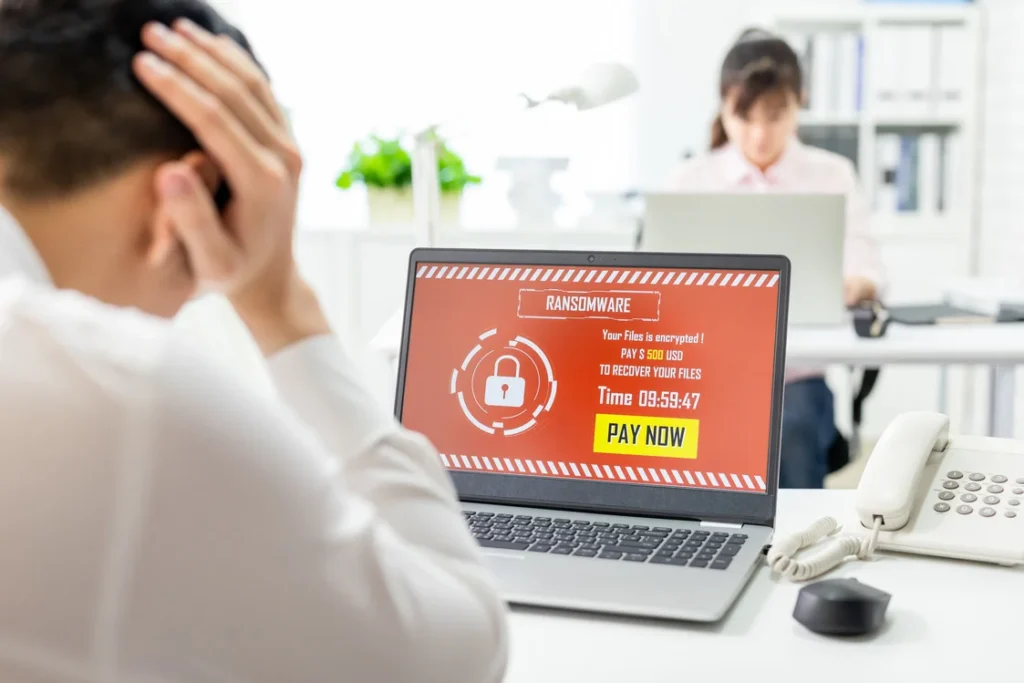It Starts with a Normal Workday
Around 7:40 AM, employees begin logging into their workstations. Project files are being opened, inboxes are filling up, and internal tools are coming online. But within minutes, something is off. A shared drive is unavailable. A financial report won’t open. Then a pop-up appears on several screens:
“Your files have been encrypted. You have 72 hours to pay or your data will be lost forever.”
This is the moment when a routine day turns into a crisis.
What follows is a fictionalized scenario based on real-world ransomware events. It’s designed to provide a behind-the-scenes look at how a ransomware attack unfolds and how a proper response strategy can make the difference between recovery and total shutdown.

Phase 1: Detection and Disruption
7:53 AM – The Attack Becomes Visible
Files across the network begin to disappear. Applications crash without warning. Entire folders vanish from the desktop. Employees begin to realize this isn’t just a glitch — something serious is happening.
The ransomware had been planted days earlier via a phishing email disguised as a supplier invoice. One click, one download, and the malware was inside. It scanned for mapped drives and vulnerable systems, then activated silently before dawn.
8:05 AM – Disruption Spreads
Phones start ringing. Internal chat systems are flooded. The IT department is overwhelmed. Rebooting doesn’t help — it spreads the encryption further. The ransomware is now affecting backup folders, databases, and internal tools.
Phase 2: Emergency Response
8:14 AM – Emergency Response Begins
An external IT response team is contacted. They identify the situation as a ransomware event and activate their emergency plan. Network access is shut down, remote logins disabled, and infected devices are quarantined.
Communication switches to secure mobile apps to avoid using compromised channels.
8:28 AM – Identifying the Threat
The ransomware strain is recognized as a variant of LockBit. It targets shared drives and poorly segmented networks. Fortunately, recent offsite, immutable backups were not affected.
Without this level of preparation, the outcome could have been far worse.
9:15 AM – Full Damage Report
System logs confirm the attack began at 3:00 AM. Around 60 devices are compromised. Key databases, email systems, and internal file servers are encrypted.
There’s a verified backup from four hours earlier, enabling restoration without ransom payment.
Phase 3: Recovery and Restoration
10:00 AM – Recovery Starts
Infected systems are wiped and rebuilt from secure templates. Backup data is validated and restored. Email, file access, and business-critical applications are brought back online in prioritized stages.
1:30 PM – Internal and External Communication
The leadership team prepares a formal message for staff and clients. It outlines the breach, confirms that no client data was accessed, and reassures everyone of the measures taken.
The tone is transparent, focused on trust and responsibility.
Phase 4: Forensics and Prevention
Day 2 – Full Forensics
The exact phishing email that triggered the attack is found. It was nearly indistinguishable from a legitimate vendor message.
Security filters are updated. MFA is enforced. Endpoint detection is improved. Staff-wide cybersecurity training begins immediately.
What Made the Fast Recovery Possible
Secure Backups
Backups were stored offsite and protected by immutability rules. The ransomware couldn’t touch them.
Incident Response Plan
The IT team followed a structured response plan, reducing guesswork and panic.
Monitoring and Endpoint Protection
Real-time monitoring and layered security tools helped prevent deeper compromise.
Why Many Businesses Aren’t So Lucky
Without secure backups, this attack could’ve forced the company to either pay the ransom or rebuild from scratch. That means days or weeks of downtime, financial loss, and legal exposure.
Some businesses never recover. In this case, the difference was preparation and quick action.
How KIS Technologies Inc. Helps Mitigate the Impact
By proactively implementing layered security, disaster recovery systems, and continuous monitoring, KIS Technologies Inc. equips businesses with the tools to withstand ransomware threats — and bounce back fast.
Final Thought: Build Resilience Before You’re Hit
Ransomware doesn’t announce itself. It doesn’t wait until Monday morning. It strikes when you least expect it.
Make sure your business has:
- Protected backups
- An active response plan
- Secured endpoints
- Cyber-aware employees
Get ransomware prevention built into your IT plan — before you need it.
